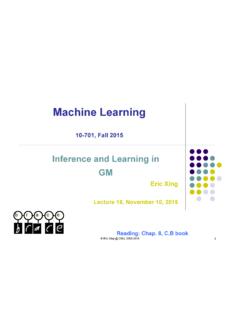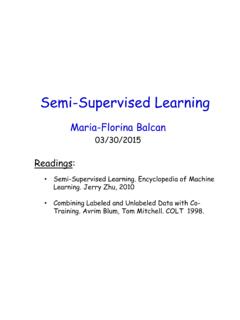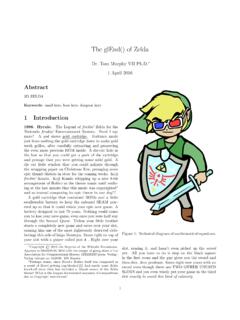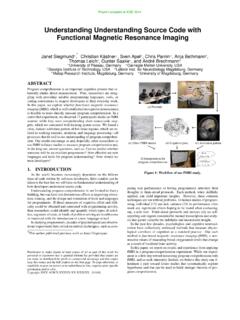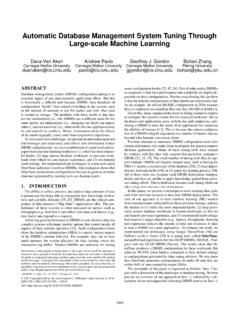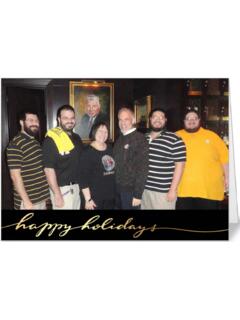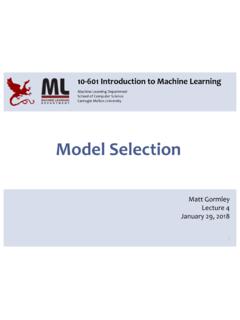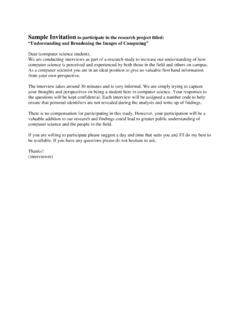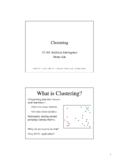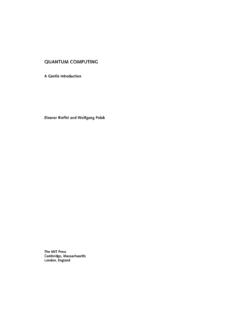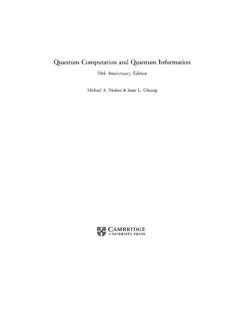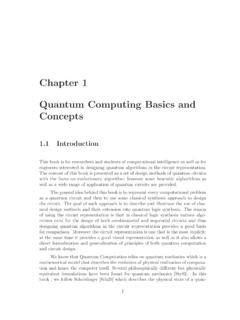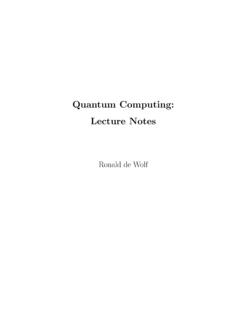Transcription of Lecture 2: Quantum Math Basics 1 Complex Numbers
1 Quantum Computation(CMU 18-859BB, Fall 2015) Lecture 2: Quantum math BasicsSeptember 14, 2015 Lecturer: John WrightScribe: Yongshan Ding1 Complex NumbersFrom last Lecture , we have seen some of the essentials of the Quantum circuit model of compu-tation, as well as their strong connections with classical randomized model of , we will characterize the Quantum model in a more formal way. Let s get started withthe very Basics , Complex numberz Cis a number of the forma+bi, wherea,b R,andiis the imaginary unit, satisfyingi2= s always convenient to picture a Complex numberz=a+bias a point (a,b) in thetwo-dimensionalcomplex plane, where the horizontal axis is the real part and the verticalaxis is the imaginary part:-Re(z)6Im(z)r 3|z|= a2+b2 abFigure 1.
2 Geometric representation of Complex numberz=a+biAnother common way of parametrizing a point in the Complex plane, instead of usingCartesian coordinatesaandb, is to use theradial coordinater(the Euclidean distance of thepoint from the origin|z|= a2+b2), together with theangular coordinate (the angle fromthe real axis). In particular, it can help us visualize geometrically what themultiplicationoperation does:Observation product of two Complex numbersz1,z2has magnitude|z1| |z2|andangle 1+ 2 is the geometric visualization of the multiplication of two Complex numbersz=a+biandz =a +b i. Another important operation on Complex Numbers is thecomplex conjugate:Definition conjugateof a Complex numberz=a+biis defined as z=a bi, also denoted asz orz.
3 1-Re(z)6Im(z)r 3|z| 1ab(a)z=a+bi-Re(z )6Im(z )r |z | 2a b (b)z =a +b i-Re(z z )6Im(z z )rBBBBBBBM|z| |z | 1+ 2(c)z z Figure 2: Geometric representation ofz z As a convention for Complex Numbers , we call the product of a Complex number with itscomplex conjugate thesquareof that Complex number, which is essentially the square of itsmagnitude:z z = (a+bi)(a bi) =a2+b2=|z|2 Notice that the result is always a real number, which becomes obvious when we realizethatz is basically a reflection ofzabout the real axis. Since the sum of their angles in thecomplex plane is 0,z z always lands on the axis. We can therefore naturally generalize theinner product for Complex product (or dot product)of twod-dimensional vectors is definedas (z1.)
4 ,zd) (w1,..,wd) =z 1w1+ +z dot product of a vector with itself now becomes:(z1,..,zd) (z1,..,zd) =|z1|2+ +|zd| Quantum BitsJust as a classical bit can have a state of either 0 or 1, the two most common states for aqubit( Quantum bit)are the states|0 and|1 . For now, let s just see the notation | as away of distinguishing qubits from classical bits. Theactualdifference though is that a qubitcan be inlinear combinationsof states, also know assuperpositions. In other words, we canwrite a Quantum state in a more general form:| = |0 + |1 ,where , C, and| |2+| |2= 1. Two other famous states that we will see very often inthis class are:|+ =1 2|0 +1 2|1 ,| =1 2|0 1 2|1.
5 We can also think of| as a vector in the two-dimensional Complex plane spanned bythe two basis states|0 and|1 . As mentioned last time, often we can view and asrealnumberswithout losing much. The reason we can sometimes ignore the fact that they arecomplex Numbers is thatCcan be easily simulated byR2. That s in fact exactly what we2did when we imagined the two-dimensional Complex plane in the previous section. Then,why do we even use Complex Numbers at all? Well, there are two major reasons: firstly, Complex phases are intrinsic to many Quantum algorithms, like the Shor s Algorithm forprime factorization.
6 Complex Numbers can help us gain some intuitions on those , Complex Numbers are often just simpler in terms of describing unknown quantumstates, and carrying out have been talking about qubits for a while, but how are theyimplemented? In factmany different physical systems can accomplish this. Although we won t cover the entirephysics behind them, a general idea of how the qubits are realized physically can sometimeshelp us understand the procedures and algorithms we are dealing with. In particular, theymight be represented by two states of an electron orbiting an atom; by two directions of thespin (intrinsic angular momentum) of a particle; by two polarizations of a photon.
7 Let s takea spin-12particle as an example. If we were to measure its spin along thez-axis, we wouldobserve that it is eitherup(in +zdirection) ordown(in zdirection). In many physicspapers, the two states are denoted as|z+ and|z , or| and| . For computationalpurposes, we can simply regard them as our good old friends|0 and|1 . Multiple Qubits and the Qudit SystemLet s begin the discussion on multiple-qubit system from the simpliest: atwo-qubit as classical 2-bit system, we have four possible computational basis states, namely|00 ,|01 ,|10 ,|11 . We can thus write a general form of the two-qubit state as follows:| = 00|00 + 01|01 + 10|10 + 11|11 ,where the amplitudes satisfy| 00|2+ +| 00|2= 1.
8 For instance, we can have auniformlymixed statewhere the scalar coefficients are the same: 00= 01= 10= 11=12. Or moreinterestingly, we can have the following state:| =1 2|00 +1 2|11 .Note that this is a system where the two qubit arecorrelated! In particular, they seem tobe always in the same state. We will come back to this interesting state very often in , it s time to the extend this to a more general case:the qudit system. Specifically, astate in thed-dimensional qudit system is a superposition ofdbasis states. We can write:| = 1|1 + 2|2 + + d|d ,where| 1|2+ +| d|2= 1 as is a qudit system implemented in physical reality?
9 In fact, particles are allowedto havespin Quantum numberof 0,12,1,32,2, etc. For example, a spin-12particle, like anelectron, is a natural qubit system, whereas a spin-1 particle, like a photon or a gluon, is a3 qutrit system. Although no fundamental particle has been experimentally found to havespin Quantum number higher than 1, the two-qubit system we mentioned earlier behavesexactly the same as a qudit system whered= 4. In theory, we could construct any quditsystem using only Qubits - the MathematicsAs we saw earlier, a Quantum state in the qubit system can be represented as a unit (column)vector in theC2plane, spanned by the following two basis state:|0 =[10],|1 =[01].
10 With a little bit of algebra, we can write a general state| as:| = |0 + |1 =[ 0]+[0 ]=[ ],where| |2+| |2= 1. Before we look into the properties of Quantum states, let s firstintroduce the style of notations we use:the Bra-ket notation, also calledthe Dirac Quantum state| is a (column) vector, also known as aket, whereas astate |is the (row) vector dual to| , also know as get a bra vector from a ket vector, we need to take theconjugate transpose. Thus wecan write: |= (| ) =[ ] =[ ].Now, suppose we have two Quantum states:|x1 = 0|0 + 1|1 and|x2 = 0|0 + 1|1 .One possible operation we can do is of course product (or dot product)of two Quantum states|x1 and|x2 isdefined as x1| |x2 , which can be further simplified as x1|x2.
